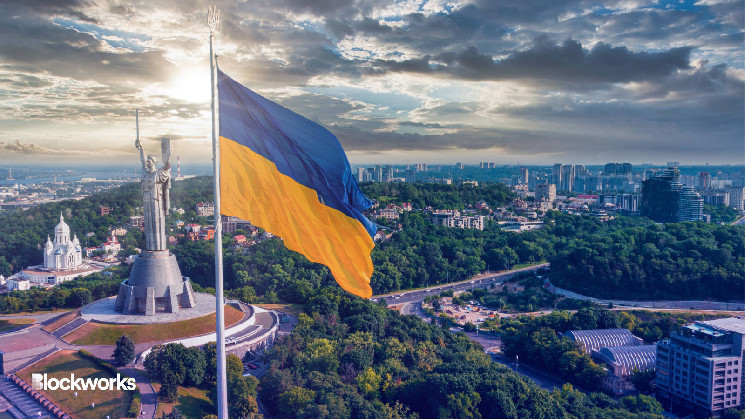Ukraine, already receptive to crypto, has one more reason to be bullish on blockchain — thanks to Stellar.
A Thursday report unpacking a two-year study on the feasibility of tapping the Stellar crypto ecosystem to move money around the war-torn country detailed a number of reasons for optimism when it comes to digital assets.
One of Ukraine’s oldest and largest banks, TASCOMBANK, led the pilot behind the study. It came about at the 2021 bequest of several of the eastern European nation’s top financial regulators and legislators.
And it’s especially relevant now, given Ukraine’s national bank has blocked local commercial banks from rolling out new forms of “electronic money” — crypto, basically — since “the first days” of Russia’s “full-scale invasion of Ukraine.”
The TASCOMBANK study, commissioned in part by Ukraine’s influential Ministry of Digital Transformation, found a number of use cases (versus its TradFi banking system) for moving around “electronic money” via Stellar — the blockchain launched by Ripple co-founder Jed McCaleb in 2014 following his exit from Ripple Labs.
The study found Stellar improved security and confidentiality of customer data, boasted far quicker and far cheaper transactions with “high throughput.”
Ukraine sees real crypto use-cases via Stellar blockchain
Ukraine’s national legislature rolled out a number of significant changes to its regulations around digital assets in 2021, around the same time the study started.
The study — parsing payments between individuals and businesses, as well as their payrolls — appears to validate a number of the cryptocurrency initiatives that were introduced at the time.
Deputy Minister of Digital Transformation Oleksandr Bornyakov said the Stellar study highlighted a number of Ukraine-specific “key advantages” of the real world use cases for blockchain tech. Ukraine regulators are considering the possibility, according to Bornyakov, of introducing additional permissions for digital assets as a result
“The results of the [pilot] proved the key advantages of blockchain,” Bornyakov said in a statement. “In particular, fast processing and cost-effectiveness of transactions, accountability and transparency of the system, and also simplified access to financial services.”
But debate over whether Stellar is sufficiently decentralized has persisted since the network went down for two hours in 2019. Then, in 2021, a string of crypto exchanges halted withdrawals after transactions began failing during a node outage.
Stellarbeat currently shows the blockchain is maintained by only 36 fully validating nodes with 13 lesser validator nodes in support — Stellar’s main rival (and McCaleb’s previous project) is supported by around 150 while Ethereum boasts hundreds of thousands.
A lower validator count puts pressure on a small group of machines to keep the network running smoothly, while larger counts allow for more of the network to go offline before service is interrupted.
Still, Stellar’s showing in the study is good news for the developing crypto dealings of TASCOMBANK. With the blessing of regulators, the bank has opened up a number of new units focused on emerging TradFi applications for distributed ledger technology (DLT).
“[The research] confirmed the readiness of the bank’s infrastructure to integrate with blockchain solutions and provide an appropriate level of financial services using virtual assets, taking into account all regulatory requirements,” the study said.
An executive for the Ukrainian financial entity went as far as to dub the resulting use cases as “drivers of the transformation of the financial landscape in Ukraine.”
It’s set to provide a new, core means for disseminating state-supplied financial assistance to Ukraine citizens.
The resulting digital payments outlook isn’t all rosy, though. There are scores of outstanding questions to tackle for both regulators and financial facilitators, both said.
One prominent one pertains to CBDCs: Who would be responsible for overseeing onboarding for its users, including know your customer (KYC) measures?
Oleksii Shaban, deputy chairman of the National Bank of Ukraine, said in TASCOMBANK’s research that the “question remains unanswered today and is closely related to another: “Whether the demand for CBDCs in a wallet opened in a commercial bank (the so-called two-level model) will be sufficient compared to that envisaged in the concept of “digital cash” – digital money as a direct claim to a central bank (the one-level model).”
The outcome demonstrates the proven potential of “real world” use cases built on the consensus-driven blockchain and “sets the foundation for greater adoption of virtual assets in Ukraine,” according to Denelle Dixon, chief executive of the Stellar Development Foundation.
Largely positive in its assessment of the current role and future potential of cryptocurrencies countrywise, the results ought to bolster a growing number of developing digital asset initiatives pioneered by Ukrainians.
Plus up-and-coming related pushes pioneered by outside players, such as the UN’s significant move to utilize the stablecoin USDC to act as the rails for disseminating humanitarian aid packages to those in need of money fast: Ukrainian refugees.
Crypto exchange Binance earlier this month struck a deal with a prominent pharmacy in the country to enable crypto-driven payments for medical products, including medicine. The rationale is to bolster Ukraine’s battered infrastructure via digital assets
David Canellis contributed reporting.
 blockworks.co
blockworks.co
